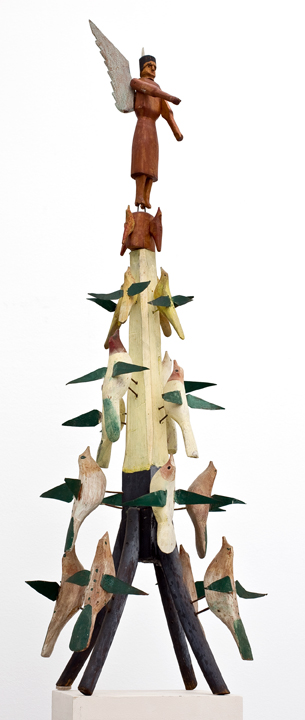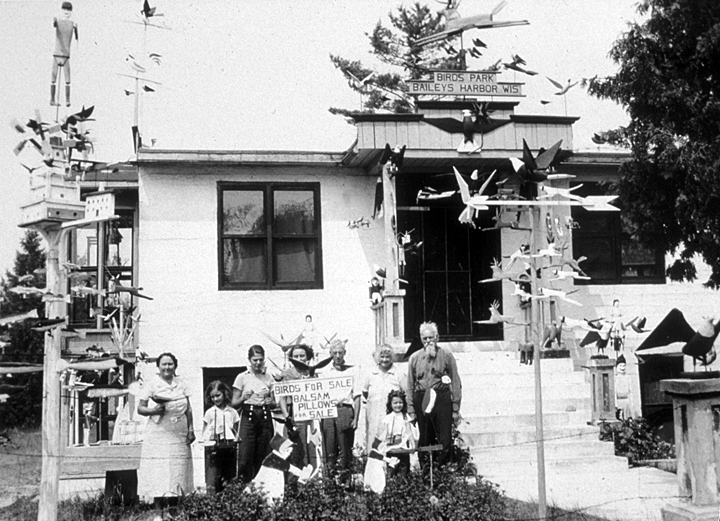Folk artist? Outsider? Visionary? Vernacular artist? Baileys Harbor resident Albert Zahn (1864-1953) was all of these. The labels point to a unusual genre of art — art made by natively talented, untrained artists whose work contains a unique vision. The renowned Grandma Moses, with her “naïve” paintings of rural America, was one such artist.
A Door County farmer for most of his life, Albert Zahn never considered himself an artist in the formal sense and might have laughed at the labels now being conferred upon him by curators and art collectors. A self-taught whittler from humble beginnings in rural Germany, he carved his whimsical wood pieces simply for the pleasure of it, but has since achieved widespread recognition for the artworks with which he decorated the exterior of his home (8223 Hwy 57, Baileys Harbor>
Over the last several decades, as national interest in American folk art grew, Zahn’s carvings were collected and displayed in museums, including the Milwaukee Museum of Art, the Guggenheim Museum, the Museum of Modern Art, and the Art Institute of Chicago. Regionally, the John Michael Kohler Arts Center in Sheboygan has become a collector of Zahn’s creations and in 2003 organized a major show of more than 200 pieces brought in from across the U.S. If he were alive today, Zahn would probably wonder what in the world his carvings were doing in a museum.
His story reveals the artistic achievement that can develop and ultimately be discovered in unexpected places. As a boy growing up in Germany, Zahn worked in the fields tending cattle, and whittling was a natural way to pass the time. His love of nature, especially wild animals and birds — plus his early religious education — inspired the subject matter of the pieces he would carve later in life.
Zahn made thousands of carvings over his long life. Whether it was a deer lawn ornament, an owl on the back of a chair, lions under a table, angels, soldiers, rabbits, roosters, or the colorful “bird trees” for which he’s become especially renowned, his approach was to always find the simplest means to create a carving, and in the shortest amount of time. And, as an extremely economical man, Zahn used condensed milk can lids to make bird wings, and coffee can lids to devise rooster wings. His wife, who painted the pieces, always used leftover house paint.
As other early Door County artists like F. DeForrest Schook and Frederick Poole were just starting to discover the Peninsula in the early 1920s, Zahn was about to retire from his life as a farmer, move inside the village of Baileys Harbor, and begin devoting more time to his carving, eventually mounting his carved birds and other wildlife to the exterior of his new home.
Answering only to his own agenda, Zahn called his hand-built home Bird’s Park, posted an “Art For Sale” sign, and unintentionally created the county’s first art gallery — in an area that has since become a nationally-recognized arts destination.
Although Zahn’s carvings have long since been removed, Bird’s Park is on the National Register of Historic Places and stands at the north end of Bailey’s Harbor, where you can clearly see it from Highway 57. The home is being restored by the current owners, but is not open to the public.




 ALL CONTENT © 2024 BY DOOR GUIDE PUBLISHING
ALL CONTENT © 2024 BY DOOR GUIDE PUBLISHING




